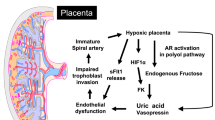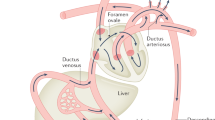Abstract
SEVERAL investigations on the sheep placenta, perfused through the umbilical vessels, have shown that this tissue synthesizes fructose and that the initial precursor is glucose1–4. These investigations were performed in preparations in which the perfusion circuit was primed initially with maternal blood. Since the maternal blood contains little or no fructose, the admixture of this blood with foetal blood (contained in the placental vessels at the time of incorporation into the perfusion circuit) results in a perfusate which has a lower fructose concentration than was originally present in the foetal blood. Under these conditions, the fructose concentration of the blood recirculating through the placenta typically rises with time. The concentration rises rapidly at first, then more slowly, to reach within 1–2 h a plateau concentration in the range of 100–150 mg/100 ml.; values commonly found in foetal sheep blood. However, in one experiment reported by Alexander, Huggett, Nixon and Widdas1 some fall was observed following the addition of fructose such that the concentration in the perfusate was greater than this range. Nixon5 found in the isolated uterus of a pregnant sheep that the placental production of fructose was very much reduced when the fructose concentration in the umbilical arterial blood was similar to that found normally in foetal blood (the uterus was maintained by perfusion circuits through both the uterine and umbilical vessels). Both Alexander6 and Nixon5 have suggested that the production rate of 5–10 mg fructose/min previously observed1 was due to the existence of a subnormal concentration of fructose in the umbilical perfusate. The purpose of the present work was to test this postulate by perfusing sheep placentae by the technique of Alexander, Huggett, Nixon and Widdas1 with different fructose concentrations in the perfusing blood.
This is a preview of subscription content, access via your institution
Access options
Subscribe to this journal
Receive 51 print issues and online access
$199.00 per year
only $3.90 per issue
Buy this article
- Purchase on Springer Link
- Instant access to full article PDF
Prices may be subject to local taxes which are calculated during checkout
Similar content being viewed by others
References
Alexander, D. P., Huggett, A. St. G., Nixon, D. A., and Widdas, W. F., J. Physiol., 129, 367 (1955).
Alexander, D. P., Andrews, R. D., Huggett, A. St. G., Nixon, D. A., and Widdas, W. F., J. Physiol., 129, 352 (1955).
Britton, H. G., Huggett, A. St. G., and Nixon, D. A., J. Physiol., 166, 21–22P (1963).
Britton, H. G., Huggett, A. St. G., and Nixon, D. A. (to be published).
Nixon, D. A., J. Physiol., 166, 351 (1963).
Alexander, D. P., thesis, Univ. London (1953).
Chinard, F. P., Danesino, V., Hartmann, W. L., Huggett, A. St. G., Paul, W., and Reynolds, S. R. M., J. Physiol., 132, 289 (1956).
Huggett, A. St. G., and Nixon, D. A., Lancet, 273, 368 (1957).
Hers, H. G., Biochem. J., 66, 30P (1957).
Andrews, W. H. H., Britton, H. G., Huggett, A. St. G., and Nixon, D. A., J. Physiol., 153, 199 (1960).
Author information
Authors and Affiliations
Rights and permissions
About this article
Cite this article
NIXON, D., ALEXANDER, D. & HUGGETT, A. Influence of Umbilical Blood Fructose on the Production of Fructose by the Perfused Placenta of Sheep. Nature 209, 918–919 (1966). https://doi.org/10.1038/209918a0
Issue Date:
DOI: https://doi.org/10.1038/209918a0
Comments
By submitting a comment you agree to abide by our Terms and Community Guidelines. If you find something abusive or that does not comply with our terms or guidelines please flag it as inappropriate.



